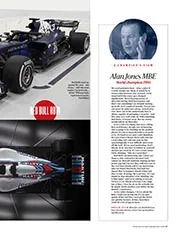
A champion's view: Alan Jones MBE
World champion 1980 We need grid girls back – what a joke! If I could change one thing, it would be to reverse that decision. But on track, I’d be…
This all-new Ford Focus is a car that does many things extremely well, but perhaps none more than illustrate the value of going for a proper test drive. For the impression I get is that of a car that should be really good, possibly even great, but feels held back.
I’ll explain. The new platform is lighter, stiffer and more spacious. The interior might not be quite as plush and intuitive as in a Golf, but it’s closer than any Ford family car in history, and feels well built. But it still feels hobbled, like Usain Bolt running in boots.
To extend the metaphor, on one foot sits the test car’s 1.5-litre diesel engine: adequate performance and strong fuel figures, but with a very limited rev range and a tendency to stall at low revs. On the other, the rear suspension. For over 20 years all Focuses have had sophisticated multi-link rear suspension. No longer: cheaper models now come with a simple torsion beam axle. There is nothing new in this policy: Volkswagen and Mercedes-Benz do the same, but the effect is the same for all: degraded ride quality and a car that is less fluent to steer. For more than two decades the Focus has set the dynamic standard for this class, and it no longer does.
Or, I should say, this one no longer does. I’ve not driven any other but would bet plenty that a petrol Focus with proper independent rear suspension will prove a car transformed, possibly even class-leading. So look before you leap, under the bonnet and at the rear suspension in particular…
Price £22,850
Engine 1.5 litres, 4 cylinders, turbo
Power 118bhp@3600rpm
Weight 1363kg
Power to weight 87bhp per tonne
Transmission Six-speed manual, front-wheel drive
0-60mph 10sec
Top speed 122mph
Economy 62.8mpg
CO2 93g/km
Verdict Cost-saving has its price